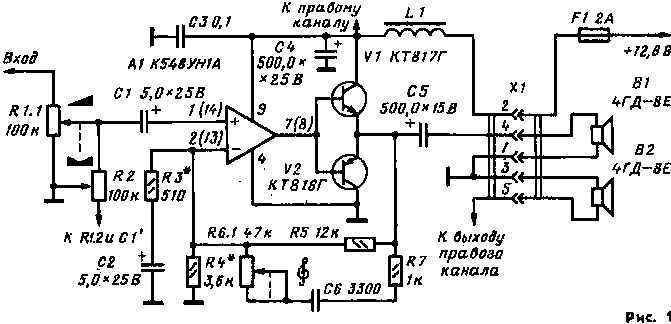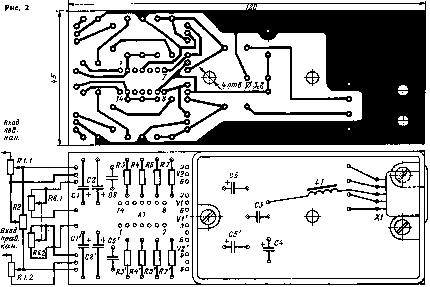
|
|
ENCYCLOPEDIA OF RADIO ELECTRONICS AND ELECTRICAL ENGINEERING A simple audio frequency amplifier on a K548UN1A chip. Encyclopedia of radio electronics and electrical engineering
Encyclopedia of radio electronics and electrical engineering / Transistor power amplifiers The stereo power amplifier offered to the attention of readers was designed for a car cassette player, but, of course, it can also be used in portable equipment with a supply voltage of 9 ... 13 V. The amplifier contains a minimum of parts, is easy to manufacture and set up, is economical, is not afraid of a short circuit in the load, and can operate at elevated ambient temperatures. In addition to adjusting the volume, it provides for adjusting the stereo balance and timbre of the sound at higher frequencies. The main technical characteristics of the amplifier are as follows:
Schematic diagram one of the power amplifier channels (the second one is identical to it) is shown in fig. one. As can be seen from the diagram, each channel contains only two stages. The first of them is made on one of the halves of the A1 dual integrated amplifier (in brackets are the pin numbers of another amplifier of the microcircuit), the second is a push-pull emitter follower. - on a complementary pair of transistors V1, V2. The amplifier is covered by OOS for direct (divider R5R4) and alternating (R5R3C2) voltages. To control the tone, a serial circuit R5C6.1R6 connected in parallel with the resistor R7 is used, which deepens the OOS at the higher frequencies of the nominal range. amplifiers without attenuation. As the slider moves up (also according to the scheme), the depth of the feedback at higher frequencies increases and the components of these frequencies are weakened. The volume is controlled by a double variable resistor R1, the stereo balance is controlled by a resistor R2. The output stage of the amplifiers (V1, V2) operates without an initial bias voltage at the bases of the transistors, i.e. in mode B. The absence of a quiescent current solves the problem of thermal stabilization of the transistor mode, which is important for automotive radio equipment and, in addition, allows you to reduce the size of the heat sink. and hence the device as a whole. The distortions of the "step" type signal waveform inherent in mode B are practically not noticeable by ear due to the large gain margin and the speed of the amplifier of the K.548UN1A microcircuit. From overload during a short circuit in the load, the output transistors are protected by an output current limiting device built into the K548UN1A microcircuit. The maximum value of this current, as you know, is 12 mA, so the collector currents of transistors V1, V2 cannot exceed the maximum allowable. The L1C3C4 filter protects the amplifier from interference from the ignition system when powered from the car's on-board network; in all other cases, when another source is used for power, it can be completely excluded. Construction and details All parts of the stereo amplifier, except for the variable resistors R1, R2 and R6, are mounted on a printed circuit board (Fig. 2) made of foil fiberglass 1,5 mm thick.
The transistors of the output stages V1, V2, V1', V2' and the female part of connector X1 (SG-5) are mounted on a heat sink bracket (Fig. 3) made of AMts-11 sheet duralumin alloy 2 mm thick. Transistors V2 and V2' are fixed on it directly, and V1 and V1' - through mica gaskets 0,03 mm thick. The bracket is connected to the printed circuit board with three screws МЗХ6 with nuts МЗ.
The amplifier uses fixed resistors MLT-0.125 (MLT-0.25), variable resistors SPZ-12, group B - (R1, R6) and SP3-12a group A (R2). capacitors K50-12 (C1, C2). K50-6 (C4, C5) and KM-6 (C3) Transistors V1, V2 must be selected according to the static current transfer coefficient h21e, which at a collector current of 0.8 A must be at least 90. Choke 1,1 is wound (until the frame is filled) wire PEV-1 0,5. The core Ш6X6 from the output transformer of the pocket receiver is used as a magnetic circuit. When assembling the inductor in the magnetic circuit, it is necessary to provide a non-magnetic gap of 0,1 ... 0,2 mm. On the printed circuit board, the inductor is fixed together with the capacitor C5. For fastening, a getinax or textolite (2,5 ... 28 mm thick) bar with a hole in the middle and an M1x2 stud with two nuts are used. With variable resistors R6, R1 and R0,1, the board is connected with a shielded wire. Setting up an amplifier, as already mentioned, is not difficult. By applying a sinusoidal signal with a frequency of 1 kHz and a voltage of 3 V to the inputs (the volume control R1 is in the maximum gain position, the stereo balance control is in the middle position), by selecting the resistor R0,3 in one of the channels, the same voltages are achieved on the load equivalents connected to the X4 connector instead of the speakers . Then increase the voltage of the test signal to 4 V and use an oscilloscope to control the shape of the signals at the outputs of both channels. Symmetrical limitation of half-waves of the signal is achieved by selecting resistors R1 and R2'. In the absence of an oscilloscope, by selecting these resistors, a voltage equal to half the supply voltage is set on the emitters of transistors VXNUMX, VXNUMX. On this, the adjustment of the amplifier can be considered complete.
The amplifier uses fixed resistors MLT-0.125 (MLT-0.25), variable resistors SPZ-12, group B - (R1, R6) and SP3-12a group A (R2). capacitors K50-12 (C1, C2). K50-6 (C4, C5) and KM-6 (C3) Transistors V1, V2 must be selected according to the static current transfer coefficient h21e, which at a collector current of 0.8 A must be at least 90. Choke 1,1 is wound (until the frame is filled) wire PEV-1 0,5. The core Ш6X6 from the output transformer of the pocket receiver is used as a magnetic circuit. When assembling the inductor in the magnetic circuit, it is necessary to provide a non-magnetic gap of 0,1 ... 0,2 mm. On the printed circuit board, the inductor is fixed together with the capacitor C5. For fastening, a getinax or textolite (2,5 ... 28 mm thick) bar with a hole in the middle and an M1x2 stud with two nuts are used. With variable resistors R6, RXNUMX and RXNUMX, the board is connected with a shielded wire. Establishment amplifier, as already mentioned, is easy. By applying a sinusoidal signal with a frequency of 1 kHz and a voltage of 0,1 V to the inputs (the volume control R1 is in the maximum gain position, the stereo balance control is in the middle position), by selecting the resistor R3 in one of the channels, the same voltages are achieved on the load equivalents connected to the X1 connector instead of the speakers . Then increase the voltage of the test signal to 0,3 V and use an oscilloscope to control the shape of the signals at the outputs of both channels. Symmetrical limitation of half-waves of the signal is achieved by selecting resistors R4 and R4'. In the absence of an oscilloscope, by selecting these resistors, a voltage equal to half the supply voltage is set on the emitters of transistors V1, V2. On this, the adjustment of the amplifier can be considered complete. Author: I. Borovik; Publication: radiokot.ru
Machine for thinning flowers in gardens
02.05.2024 Advanced Infrared Microscope
02.05.2024 Air trap for insects
01.05.2024
▪ Rules for testing robotic vehicles ▪ Seagate is the first to equip an external hard drive with a 4G LTE modem ▪ Solar panels from cheap raw materials
▪ Telephony site section. Article selection ▪ article GPS navigation system. History of invention and production ▪ article How fast do trees grow? Detailed answer ▪ article Electrician for the repair of electrical equipment. Job description ▪ Antenna article. Theory. Directory
Home page | Library | Articles | Website map | Site Reviews www.diagram.com.ua |






 Arabic
Arabic Bengali
Bengali Chinese
Chinese English
English French
French German
German Hebrew
Hebrew Hindi
Hindi Italian
Italian Japanese
Japanese Korean
Korean Malay
Malay Polish
Polish Portuguese
Portuguese Spanish
Spanish Turkish
Turkish Ukrainian
Ukrainian Vietnamese
Vietnamese




 Leave your comment on this article:
Leave your comment on this article: